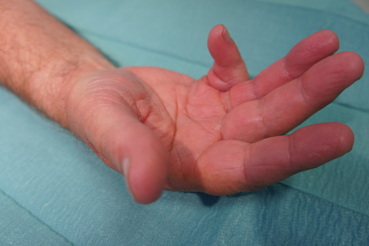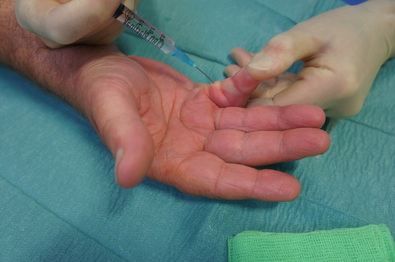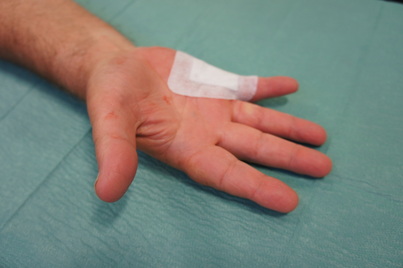 Before Needle Aponeurotomy
Before Needle Aponeurotomy
Why choose needle aponeurotomy?
I often recommend needle aponeurotomy as the first-line treatment for Dupuytren's disease because:
- it is the least invasive technique
- recovery is usually quickest from this technique
- there is minimal "downtime" after the procedure
(one of my patients was back at work 30mins later!)
- several fingers or involved areas can be treated at the same time
- it does not make further or different types of surgery more difficult
- the risk of complications is low
- it can be performed as a daycase, under local anaesthetic, in a timely fashion
I often recommend needle aponeurotomy as the first-line treatment for Dupuytren's disease because:
- it is the least invasive technique
- recovery is usually quickest from this technique
- there is minimal "downtime" after the procedure
(one of my patients was back at work 30mins later!)
- several fingers or involved areas can be treated at the same time
- it does not make further or different types of surgery more difficult
- the risk of complications is low
- it can be performed as a daycase, under local anaesthetic, in a timely fashion
What are the disadvantages of needle aponeurotomy?
Needle aponeurotomy only breaks the Dupuytren's cord contractures (allowing the finger to straighten) without removing any of the disease itself. The recurrence rate of contracture (bending of the fingers) is therefore higher using this technique compared to others. However many people accept this higher recurrence rate knowing that they might have to come back for repeat "needling" every couple of years. As they can usually go back to work in a day or two, they still prefer this to taking weeks off work (or out of their lives) as is often required with other techniques.
Needle aponeurotomy only breaks the Dupuytren's cord contractures (allowing the finger to straighten) without removing any of the disease itself. The recurrence rate of contracture (bending of the fingers) is therefore higher using this technique compared to others. However many people accept this higher recurrence rate knowing that they might have to come back for repeat "needling" every couple of years. As they can usually go back to work in a day or two, they still prefer this to taking weeks off work (or out of their lives) as is often required with other techniques.
 Needle being used to divide cord after numbing
Needle being used to divide cord after numbing
What does needle aponeurotomy involve?
- you come in as a day-case and can usually go home around 30mins after the procedure
- you lie down on a couch with you hand out to the side on a small table
- for each cord to be divided you have an injection of a tiny amount of local anaesthetic directly over the cord, after this you should not feel any more pain from the needle. However if you should feel anything you can tell me, and I will numb the finger a bit more. Depending on how many areas or cords need dividing will determine how many of these tiny injections you will require.
- once the cord is weakened I will try straightening the finger to fully break the cord, and this pulling may cause a bit of discomfort. You may feel the cord give way, or sometimes even here is snap. Don't be concerned, this is entirely normal, and is what I am aiming to achieve as it will help straighten the finger.
- at the end I will put a simple plaster over the area, which can normally be removed the following day, and you can start washing your hands as normal again.
- you come in as a day-case and can usually go home around 30mins after the procedure
- you lie down on a couch with you hand out to the side on a small table
- for each cord to be divided you have an injection of a tiny amount of local anaesthetic directly over the cord, after this you should not feel any more pain from the needle. However if you should feel anything you can tell me, and I will numb the finger a bit more. Depending on how many areas or cords need dividing will determine how many of these tiny injections you will require.
- once the cord is weakened I will try straightening the finger to fully break the cord, and this pulling may cause a bit of discomfort. You may feel the cord give way, or sometimes even here is snap. Don't be concerned, this is entirely normal, and is what I am aiming to achieve as it will help straighten the finger.
- at the end I will put a simple plaster over the area, which can normally be removed the following day, and you can start washing your hands as normal again.
 5 mins later the finger is straight
5 mins later the finger is straight
What are the risks from needle aponeurotomy?
All procedures on the hand carry a risk of bleeding, infection, pain, swelling, scarring and very occasionally an abnormal pain reaction to surgery (1 in 4000). However these risks are particularly low for needle aponeurotomy. Specific risks to this procedure are:
- tears to the skin: although the needle only makes a small puncture hole through the skin, if the cord to be divided is also firmly fixed to the skin then a small tear may occur in the skin as the finger is straightened. These tears are almost always allowed to heal in quicklyby themselves without further action required. You may need to wear a dressing for a few more days.
- damage to tendons: when performed by a hand surgeon this is very rare indeed as we have an excellent understanding of the anatomy of the hand, even when not visible beneath the skin. However should tendon damage occur it can be repaired, but may will slow down recovery.
- damage to nerves: the technique I use minimises the risk of damaging nerves, but just like with tendons, I would repair the nerve should this occur. If completely divided there would be numbness down the side of the finger that nerve supplies until the nerve grows back down.
All procedures on the hand carry a risk of bleeding, infection, pain, swelling, scarring and very occasionally an abnormal pain reaction to surgery (1 in 4000). However these risks are particularly low for needle aponeurotomy. Specific risks to this procedure are:
- tears to the skin: although the needle only makes a small puncture hole through the skin, if the cord to be divided is also firmly fixed to the skin then a small tear may occur in the skin as the finger is straightened. These tears are almost always allowed to heal in quicklyby themselves without further action required. You may need to wear a dressing for a few more days.
- damage to tendons: when performed by a hand surgeon this is very rare indeed as we have an excellent understanding of the anatomy of the hand, even when not visible beneath the skin. However should tendon damage occur it can be repaired, but may will slow down recovery.
- damage to nerves: the technique I use minimises the risk of damaging nerves, but just like with tendons, I would repair the nerve should this occur. If completely divided there would be numbness down the side of the finger that nerve supplies until the nerve grows back down.